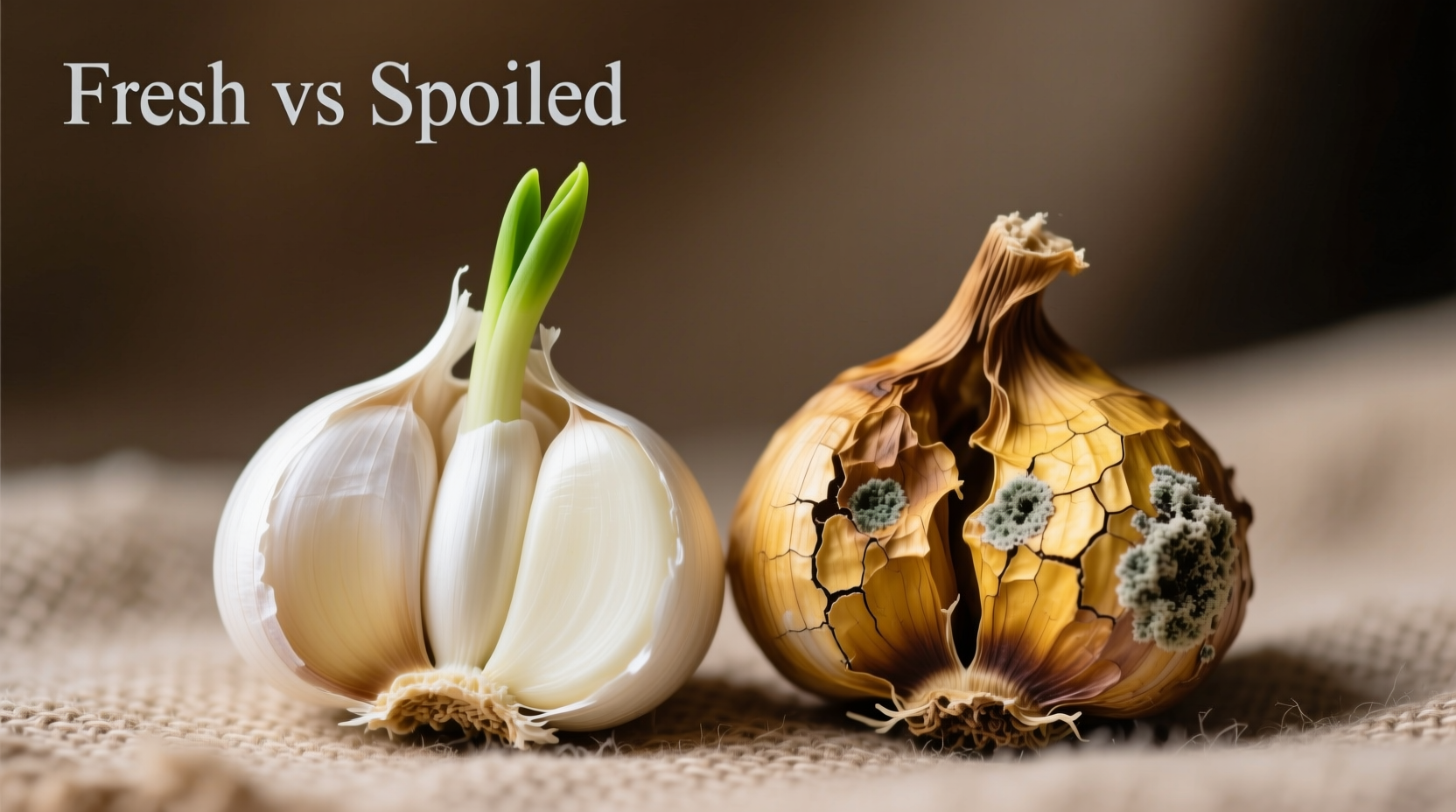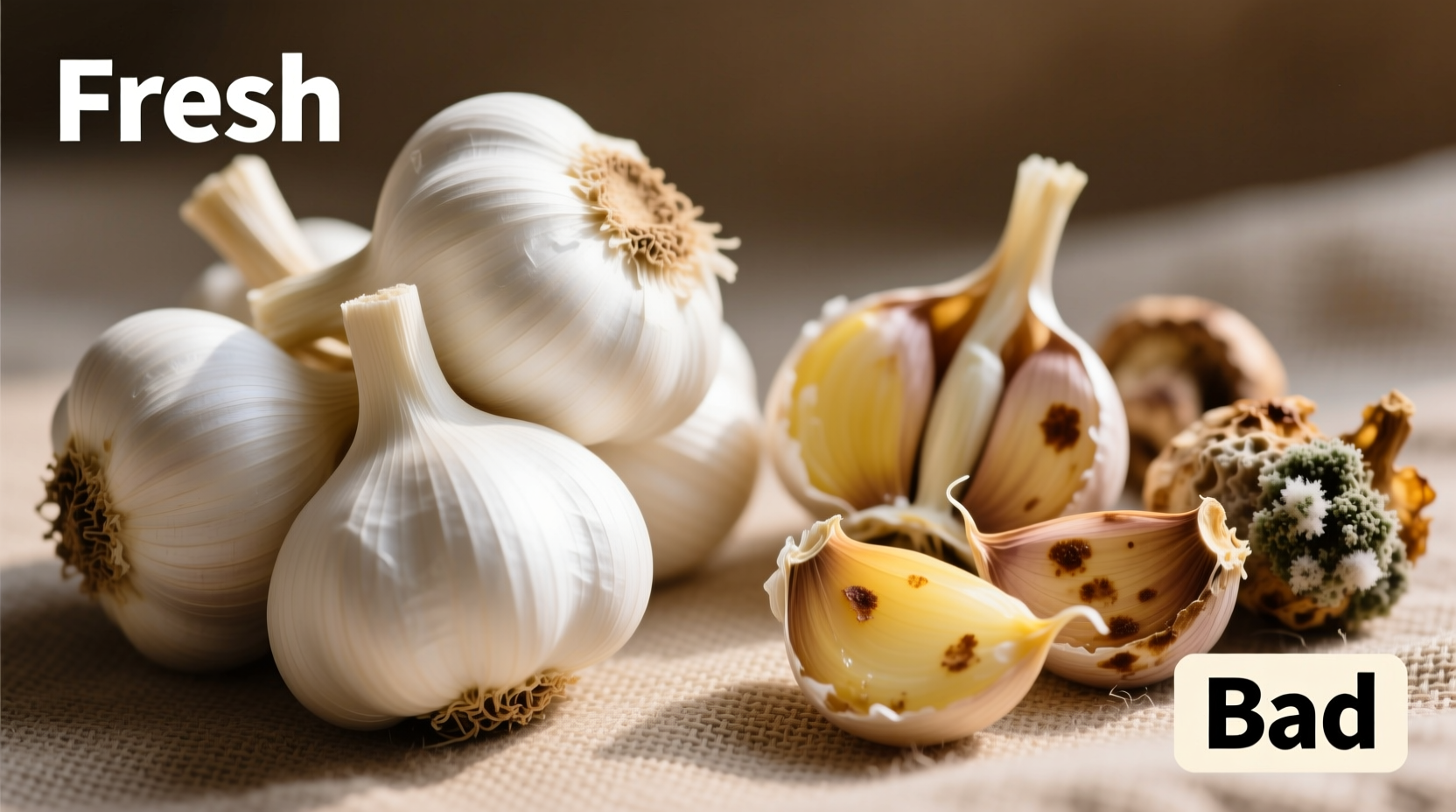Knowing how to identify spoiled garlic prevents food waste and protects your health. As a culinary professional who's handled thousands of garlic bulbs throughout my career, I've developed a reliable system for determining garlic freshness that goes beyond basic visual checks. This guide provides practical, science-backed methods anyone can use to assess garlic quality with confidence.
Visual Indicators of Spoiled Garlic
Garlic's appearance offers the first clues about its condition. While some changes are normal aging, others signal definite spoilage:
| Condition | Good Garlic | Bad Garlic |
|---|---|---|
| Texture | Firm to hard when squeezed | Soft spots, mushy areas, or slimy coating |
| Color | White or purple-tinged papery skin | Yellow, brown, or black discoloration |
| Surface | Intact, dry outer layers | Mold growth (white, green, or black) |
| Internal | Crisp white cloves | Brown or yellow spots inside cloves |
This comparison helps distinguish normal aging from actual spoilage. According to USDA food safety guidelines, any visible mold on garlic requires immediate disposal as mold can penetrate deeper than visible surfaces.
Sprouting: Natural Process vs. Spoilage Signal
Green sprouts emerging from garlic cloves often cause confusion. While sprouting indicates aging, it doesn't automatically mean the garlic has spoiled:
- Edible sprouts: Bright green, firm sprouts can be removed; the remaining garlic remains safe to use
- Danger signs: Brown-tipped, wilted sprouts accompanied by soft cloves indicate spoilage
- Flavor impact: Sprouted garlic develops a slightly bitter taste but remains safe if firm
Cornell University's food safety program notes that sprouting occurs as garlic attempts to grow under warm conditions, but doesn't compromise safety unless accompanied by other spoilage indicators.
Sensory Checks: Smell and Texture Assessment
Your senses provide critical information about garlic quality:
Smell Test Protocol
Fresh garlic emits a clean, sharp aroma. Perform these checks:
- Slice a small piece of the clove
- Sniff immediately - fresh garlic has a clean, pungent scent
- Discard if you detect sour, unpleasant, or "off" odors
The distinctive garlicky smell comes from allicin, which breaks down as garlic spoils. A weakened aroma often precedes visible spoilage.
Texture Examination
Properly stored garlic maintains firmness. When checking texture:
- Squeeze gently - fresh garlic resists pressure
- Watch for indentations that remain after pressing
- Check for slimy film on cloves or inside packaging
Soft spots indicate enzymatic breakdown that accelerates spoilage. The FDA recommends discarding garlic that feels soft or mushy as these conditions promote bacterial growth.

Storage Timeline: When Garlic Becomes Unsafe
Understanding garlic's shelf life helps prevent consumption of spoiled product:
- Whole bulb at room temperature: 3-5 months in cool, dark place
- Separated cloves: 7-10 days at room temperature
- Refrigerated peeled cloves: 7-14 days in airtight container
- Garlic in oil: Maximum 4 days refrigerated (botulism risk)
University of California's food safety extension warns that storing garlic in oil at room temperature creates ideal conditions for Clostridium botulinum growth, which causes botulism. Always refrigerate garlic-oil mixtures and use within four days.
Common Misconceptions About Garlic Spoilage
Several myths persist about garlic quality that lead to unnecessary waste:
- Misconception: Purple hues indicate spoilage
- Reality: Many varieties naturally have purple streaks; only discard if accompanied by softness or odor
- Misconception: All sprouted garlic is dangerous
- Reality: Remove green sprouts from firm cloves; only discard if cloves are soft
- Misconception: Refrigeration always extends freshness
- Reality: Whole bulbs last longer at room temperature; refrigeration promotes sprouting
Proper Storage Techniques to Maximize Freshness
Follow these evidence-based storage methods to extend garlic's shelf life:
Room Temperature Storage
Store whole bulbs in a cool, dark, well-ventilated area:
- Use mesh bags or paper bags with ventilation holes
- Maintain temperatures between 60-65°F (15-18°C)
- Avoid plastic bags which trap moisture and accelerate spoilage
Refrigeration Guidelines
Refrigerate only when necessary:
- Peeled cloves: Store in airtight container for up to 2 weeks
- Chopped garlic: Mix with a small amount of oil and use within 1 week
- Never store whole bulbs in refrigerator (promotes sprouting)
The National Center for Home Food Preservation recommends against storing garlic in oil at room temperature due to botulism risks, a serious food safety concern that requires immediate attention.
When to Definitely Discard Garlic
Some conditions require immediate disposal without exception:
- Visible mold growth in any color
- Soft, mushy texture throughout the clove
- Sour or unpleasant odors
- Garlic stored in oil for more than 4 days
- Any signs of fermentation (bubbling, liquid separation)
When in doubt, throw it out. Consuming spoiled garlic can cause foodborne illness with symptoms including nausea, vomiting, and diarrhea. The USDA Food Safety and Inspection Service emphasizes that mold on garlic can produce mycotoxins that aren't destroyed by cooking.
Practical Tips for Garlic Safety
Implement these professional techniques to ensure garlic safety:
- Inspect garlic before purchase - avoid bulbs with soft spots
- Store away from potatoes which emit moisture-accelerating gases
- Rotate stock using oldest garlic first
- Label refrigerated garlic with dates to track freshness
- When roasting, check for spoilage before wrapping in foil
Professional kitchens follow the "sniff, squeeze, slice" protocol before using any garlic: smell for off odors, squeeze for firmness, and slice to check internal condition. This three-step verification prevents spoiled garlic from entering dishes.











 浙公网安备
33010002000092号
浙公网安备
33010002000092号 浙B2-20120091-4
浙B2-20120091-4